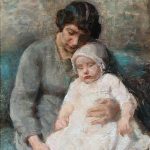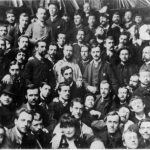Théo Van Rysselberghe was a Belgian painter who lived from 1862 to 1926. He was born in Ghent, Belgium, on November 23, 1862, to a wealthy family. His father was a lawyer, and his mother came from a wealthy family, which allowed Van Rysselberghe to grow up in a cultured and privileged environment.
Early Life and Education
Van Rysselberghe was exposed to art and literature from an early age. He began studying at the Académie Royale des Beaux-Arts in Brussels in 1879, where he was taught by the Belgian painter Jean-François Portaels. Portaels encouraged Van Rysselberghe to pursue a career in art and was instrumental in shaping his early artistic style.

In 1882, Van Rysselberghe left the Académie Royale des Beaux-Arts and moved to Paris to continue his studies. He studied at the Académie Julian and was exposed to the works of the Impressionists and Post-Impressionists, which had a significant influence on his later artistic style.
Early Career
Van Rysselberghe began exhibiting his work in Brussels and Paris in the early 1880s. Initially influenced by the Realist and Naturalist movements, he soon became interested in the Impressionists’ use of light and color. He began experimenting with the techniques of the Impressionists, but he felt that their approach was too subjective and lacked structure.

In 1886, Van Rysselberghe met the French painter Georges Seurat, who had developed a new style of painting known as Pointillism. Pointillism involved applying small dots of pure color to the canvas, which would then be blended by the viewer’s eye. Van Rysselberghe was immediately drawn to this technique, and he began experimenting with it in his own work.
In 1887, Van Rysselberghe and a group of fellow artists founded the avant-garde art group Les XX. The group was dedicated to promoting new and innovative styles of art, and it quickly became one of the most important artistic movements in Europe. Van Rysselberghe exhibited his work at the group’s annual exhibitions and became known for his use of Pointillism.
Mature Work
In the 1890s, Van Rysselberghe’s work began to evolve. He moved away from the strict rules of Pointillism and began experimenting with other techniques, such as the use of larger brushstrokes and the application of pure color in patches. He also began to focus more on the effects of light and color, and his paintings became more luminous and atmospheric.

In 1892, Van Rysselberghe visited Italy, where he was inspired by the works of the Renaissance painters. He began to incorporate elements of Renaissance art into his own work, such as the use of perspective and the depiction of human figures in classical poses. He also began to experiment with other styles, such as Fauvism and Symbolism.
Van Rysselberghe continued to exhibit his work throughout Europe in the early 1900s. He participated in the Salon des Indépendants in Paris and the Secessionist exhibitions in Vienna and Munich. He also exhibited his work at the Venice Biennale in 1903 and 1907, where he won a gold medal.

In 1913, Van Rysselberghe moved to Saint-Clair, France, where he lived for the rest of his life. He continued to paint and exhibit his work, but his output slowed down as he grew older. He died on December 14, 1926, at the age of 64.




